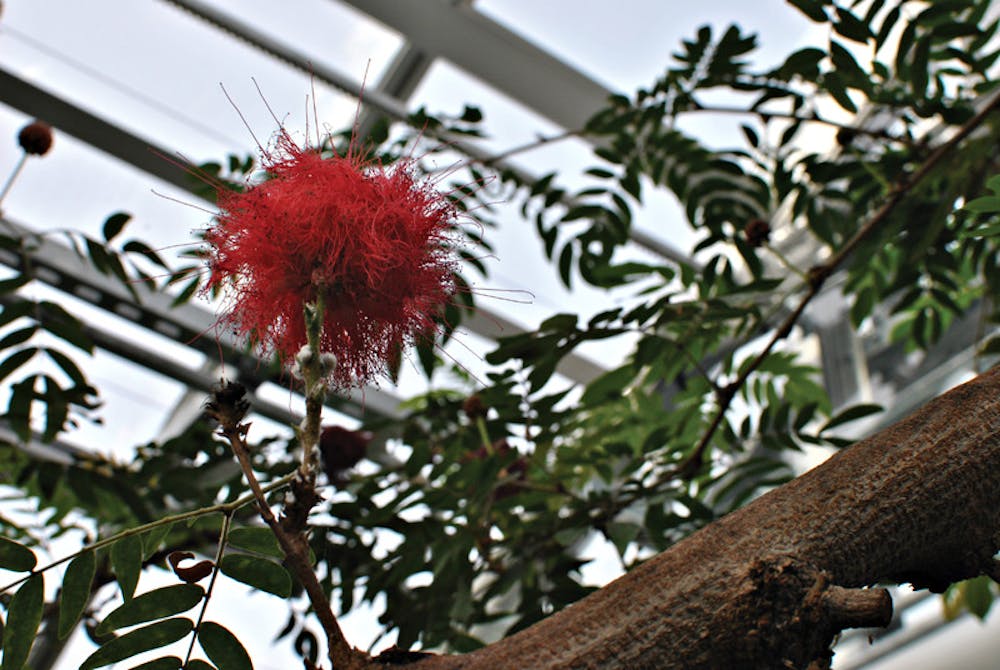Sitting atop the new Building for Environmental Research and Teaching, the Plant Environmental Center — the University’s new greenhouse and conservatory — houses innovative technology for research on climate change and other leading areas of study.
The rooftop building — a metallic, crown-shaped structure diverging from classic greenhouse architecture — is in the final stages of completion, and will soon have scheduled visiting hours, tours and events, said Fred Jackson, PEC director and teaching associate in ecology and evolutionary biology.
The new roof installment houses six rooms specifically designed for research, each with independent climate controls and adjustable vents, shades and lights, Jackson said.
The ability to simulate different environments allows researchers to explore how plants will respond to changing conditions, he said, adding that the computerized research chambers will create an immense database recording various conditions.
Seventeen environments with completely programmable conditions and a classroom are located in BERT’s basement, said Mark Johnson, associate professor of biology and the greenhouse’s faculty director. He added that the facility also features a head house — a special room for potting plants.
The biggest advantage of the new greenhouse is its ability to develop different growing environments for experiments, creating “modular space,” Johnson said. The basement’s growth chambers allow for more controllable factors than the roof research rooms do, he added, noting that researchers can adjust carbon dioxide concentrations in the chambers and mimic an increase in atmospheric carbon dioxide levels.
These new technologies allow researchers to test climate projections and examine climate change’s effects on plant life, Johnson said. Researchers can also modulate the amount and quality of light by adjusting the wavelength, he added.
The space will allow “people studying climate change to work together in an interdisciplinary environment” and will facilitate opportunities for “new types of research that we haven’t been able to do before,” Johnson told Rhode Island NPR.
Four faculty members and their lab groups will move into the labs, but there is potential “room to expand,” Johnson said. He added that he expects researchers associated with the Department of Ecology and Evolutionary Biology, the Environmental Change Initiative and the Department of Geological Sciences will utilize the space, along with other faculty members.
Along with the additional research space and technology, the University has hired Christopher Claussen as plant growth facilities manager.
Undergraduates have opportunities to become involved with greenhouse research, Johnson said, highlighting one ongoing undergraduate experiment that seeks to understand how temperature affects the production of different varieties of tomato plants. Johnson said this project might preface other research on the effect of rising temperatures on food production, especially for crops such as rice and corn.
The new PEC will house many of the same exotic plants as the old greenhouse, which was located next to Simmons Quadrangle and Metcalf Chemical Laboratory. Though the new conservatory is slightly smaller than the old one, its “light is phenomenal,” Jackson said, adding that the plants are responding well to their new home.
The plants housed in the new conservatory include a brain cactus, a 30-year-old bonsai tree, a banana plant, a coffee plant and a jatropha plant called “Buddha’s Belly,” Jackson said.
Accessibility to such an interesting collection of plants is a “great way for the research community to interact with Providence,” Johnson said.
The greenhouse installment was funded by a $5.5 million donation that was approved by the Corporation last spring, The Herald previously reported. Construction began in August 2012, and the contents of the old greenhouse were moved to the new facility last November, wrote BERT Project Manager John Cooke in an email to The Herald.
“Demolition of the existing greenhouse is nearing completion,” Cooke wrote. In its place, a continuation of the pathway that currently connects the Pembroke campus to Waterman Street will be constructed when the ground thaws, Johnson said.
Facilities Management and Gilbane Building Company make up the project team responsible for oversight of the new greenhouse’s construction, Cooke wrote, adding that renovations have gone according to schedule and “the first occupants in the building moved into the facility over the winter break.”

ADVERTISEMENT




